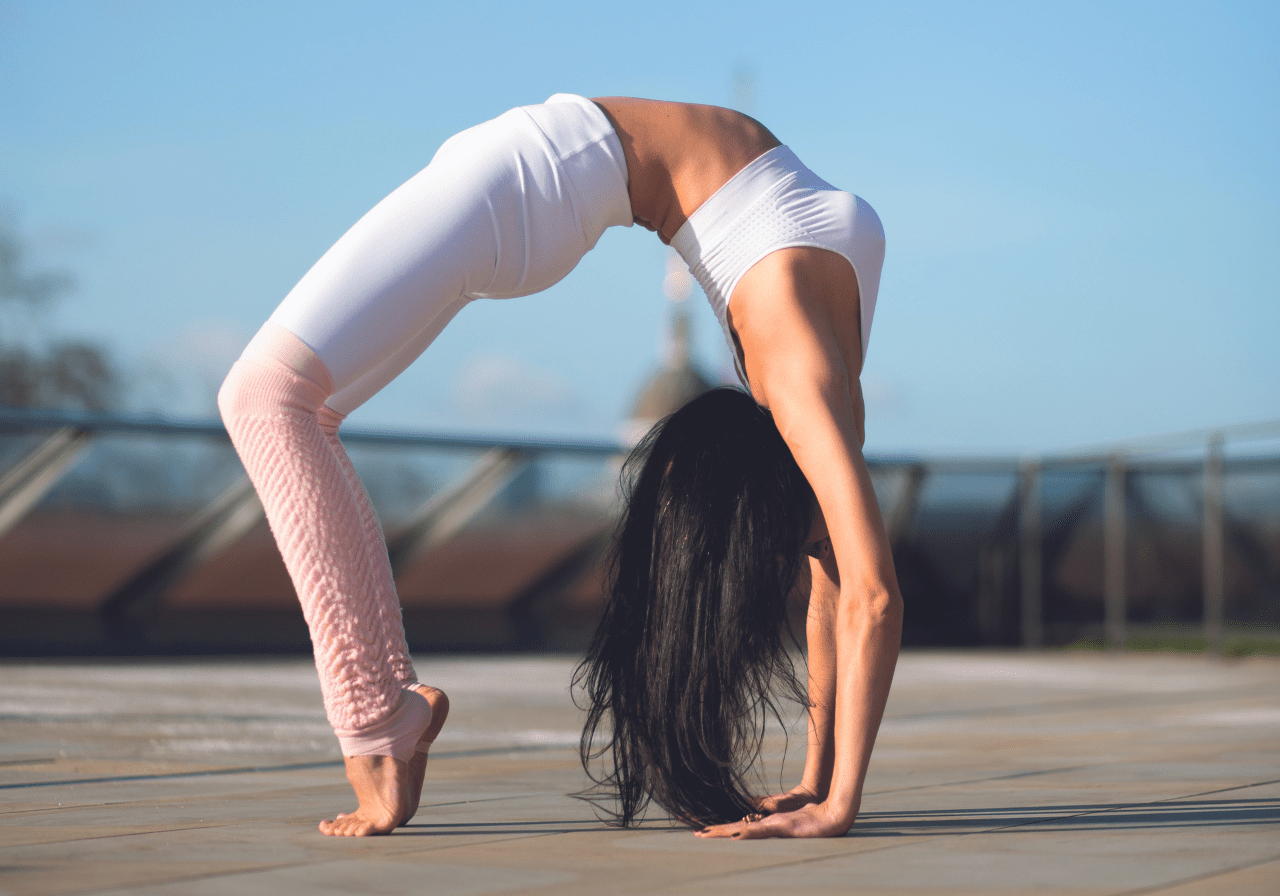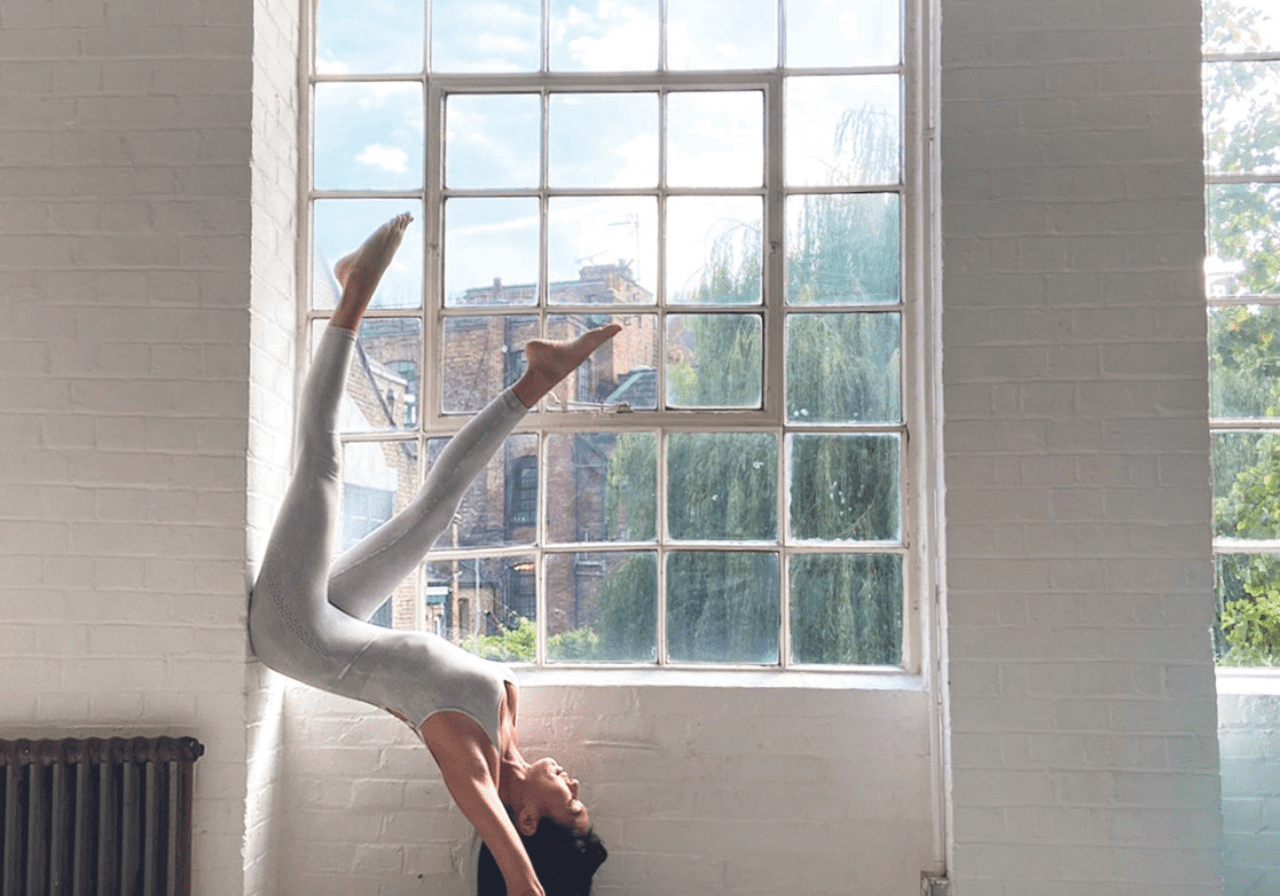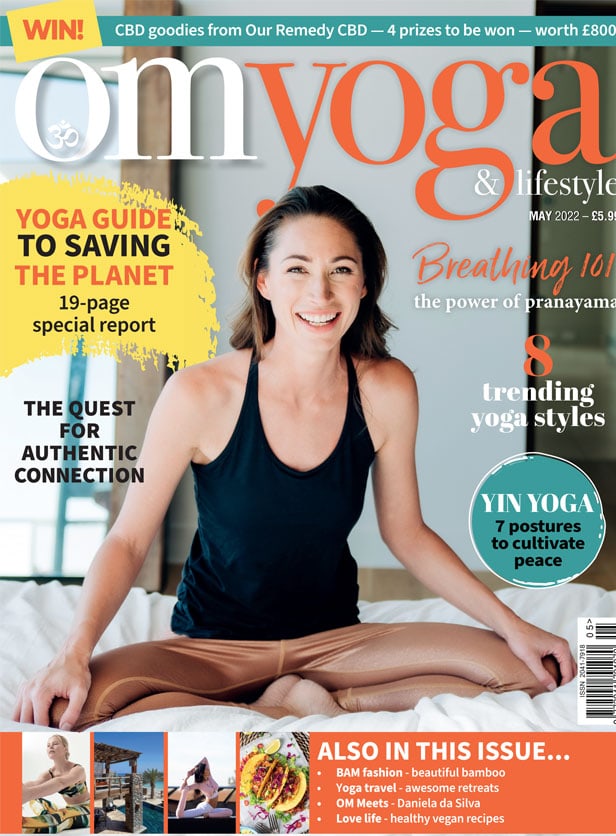
OM meets...
DANIELA DA SILVA
Founder of Blue House Yoga and a teacher to celebrities like the Beckhams, Daniela da Silva has come a long way since her early years in Brazil. She’s now pioneering in the acceptance of cryptocurrencies for retreat payments and embedding modern psychology into her classes
How did you first get into yoga?
 Yoga happened to me in my mid-twenties. At that time, I was looking for my spiritual identity and change. I came across a yoga teacher training (Swasthya Yoga) based in Florianopolis and enrolled in 2008. Months after, armed with the courage of youth, I was giving yoga classes at a community centre in Itajai, on the south coast of Brazil. In that same year, I decided to move to the UK, but my English was non-existent, so I taught private lessons to any Portuguese-speaking person I could find. From the beginning, I found in yoga all that I was searching for.
Yoga happened to me in my mid-twenties. At that time, I was looking for my spiritual identity and change. I came across a yoga teacher training (Swasthya Yoga) based in Florianopolis and enrolled in 2008. Months after, armed with the courage of youth, I was giving yoga classes at a community centre in Itajai, on the south coast of Brazil. In that same year, I decided to move to the UK, but my English was non-existent, so I taught private lessons to any Portuguese-speaking person I could find. From the beginning, I found in yoga all that I was searching for.
What inspired you in those early days?
I grew up lacking a father figure, and found in yoga a metaphor for self-discipline or tough love; that is how I interpret my preference for physically challenging practices. In other words, what originally inspired me in my early days was that yoga represented masculine energy in my life, a promise that if I kept going, I was going to be rewarded in the future.
What does yoga give you personally?
Yoga gives me a stable home, which for me, is not a place but a feeling. In 1996, a fire burned down my house. My twin brothers (both aged four) tragically died in the accident. As a consequence of this loss, I became disconnected from my body for decades, never feeling safe or at home. My practice became a way of healing (until five years ago, I would still cry hard at the end of a yoga class). I am the living proof that asanas can touch hidden grief in our bodies; the crying was a passage for letting go of it! Now I feel that I have made peace with the past, and yoga was the mediator.
Any favourite teachers or studios or places?
So many! Before the pandemic, I took classes with Stewart Gilchrist. His style works for me. Gilchrist is direct, and to take his class, one must have a thick skin and be prepared to use reserves of stamina. So many places come to my mind when I think of studios. I live in London and love triyoga. Also, the last time I was in Stockholm, I had a few classes at Yogayama and truly enjoyed Shay Peretz’s guidance.
How have you coped during the challenging past two years?
I opened a 'virtual yoga studio'. At the peak of the pandemic, I taught 10 weekly classes, which kept me busy. It was certainly challenging in terms of social life, but I got used to being with my daughter and cat only, as well as navigating a long-distance relationship. Still, I was aware that I should nurture gratitude.
How would you describe your teaching style?
I like to think of it as adaptive and informative. I prefer teaching complex asanas and physically demanding sequences, but soon I realised that my demographics were too eclectic for me to be too fixed when delivering lessons. In terms of themes, I am finishing a degree in psychology, and often I will drop in a theory or study in the class.
For instance, yogis are familiar with catchy phrases such as 'energy flows where attention goes.' In psychology, there is a term known as RAS or articulated reticular system, a bundle of nerves that literally 'filters' unnecessary information and validates our beliefs: similar messages, different languages! I feel that knowledge gives us a big incentive (or ‘why’) when pursuing something. With the scientific plus philosophical appeal, one can touch more hearts with one shot!

Yoga career highs so far?
Growing up, I loved The Spice Girls and joined a tribute band at school, just for fun. I chose to be Posh Spice and remember cutting my hair in a bob style to resemble Victoria. Fast forward to 2018 and the Beckhams hired me to teach them headstands. The couple posted our classes on their stories on Instagram, and that was very helpful for my career. Pure luck, maybe, but I also believe that a desire made with a pure heart has its own life. As a teenager, I was her fan and wished to meet her, so there we go!
What prompted you to accept cryptocurrency on your retreats?
I started to allow crypto as payment because, in 2019, I met some crypto traders who suggested that accepting it as payment would give my business an 'edge'. Not many teachers accept this form of payment, so I saw the opportunity to become one of the first. Some clients feel safer funding their holidays with crypto than PayPal or credit cards. Initially, my website was only optimised to accept payments in pound sterling through processors such as Stripe and PayPal.
But with the increase in the number of cryptos available, I've had customers request to pay in this way. In both corporate yoga, especially working with tech businesses, and when organising retreats or selling online products, allowing crypto as payment is a way forward to tap into the early adopters and buyers who happen to practice yoga.
What are your plans going forward?
To develop a trauma releasing therapy rooted in yoga practice and psychotherapy. In my vision, this therapy will require an additional commitment and three weeks of yoga classes, with a minimum three times a week before talk therapy.
Any advice for new yoga teachers starting out?
Believe in yourself, be creative and find a way to tap into niches that only you can with your past experiences and expertise. I see a lot of aspiring instructors suffering from paralysis from analysis. I understand how overwhelming it can be with so many options and styles, so my suggestion is to experience different settings to see what is closest to your heart. Finally, take advantage of advances in technology, design your website, put some thought into your social media and freelance as much as possible. Studios are more likely to give opportunities to experienced teachers. Establishing yourself will require hard work, but it is also rewarding work.

What do you know now that you wish you'd known at the start?
I wish I had known that I didn't know as much as I thought I did! I thought I knew everything it took to be a great teacher and that I could do it as well as some senior teachers. But there is nothing like experience to humble you. I thought that my background gave me enough 'content' to speak to people's hearts, but now I know that wisdom lies not in the trauma version of ourselves, but in the healed version.
Do you think yoga teachers should keep parallel careers running, especially early on?
I don't see why not, but in general, I think it is more a matter of circumstances and personal preferences. Earning a living as a yoga instructor is not necessarily a linear path. It will depend on levels of passion, location and finances. Furthermore, the profession is different for different people. Some may have only just started, but they have contacts or something going on in their lives that allows abundance to flow immediately. Others, no matter how good they are, will face adversities, and sometimes the option to teach full-time is not quite there yet.
Any tips for students new to yoga?
For students who came to yoga exclusively to keep fit, I would advise them to explore its spiritual side. I don't have a problem with it, but there is so much emphasis on fitness in yoga nowadays that the lines are blurred. Still, a seed planted can always flourish into a beautiful tree. On the opposite side, for students who are disappointed with the mass commercialisation of the practice, I encourage them to look at things through the bright side and trust that yoga acts in mysterious ways.
What do you say to those who feel they can't do yoga because they're not in shape, too old or too inflexible?
We can look at our perceived limitations in life as an excuse to quit or as an opportunity to start! It depends on how we communicate a decision to do it (or not) to ourselves. Moreover, the right time to start anything is always now, not in the past or in the distant future.
What do you do when you're not doing yoga?
I read, travel, roller skate and enjoy cooking.
Any tips for incorporating yoga into ordinary activities?
Pranayama: now and again, simply pay attention to the breath. It's a great way to start to feel sensations within our bodies and manipulate energy.
Any thoughts on inclusivity and body positivity in yoga?
I am a size 8, and to express my opinion on this issue has been polemic. “Easy for you to say,” I have heard once or twice.
But for me, body positivity was initially supposed to help people understand the media's contribution to our feelings about our bodies, exercise, food, clothing, health, and identity. Saying that, I love and support all efforts to make yoga less stereotypical and spread the practice to everybody; on the other side of the coin, yoga requires discipline, and spirituality involves self-care.
The changes that happen in our bodies due to ageing or pregnancy must be cherished but (I said this was going to be polemic!) changes in the body because of lifestyle choices are sometimes avoidable. Does the fashion industry create a problem with patterns of beauty? Yes, totally. But does the food industry and modern lifestyles promote over-consumption and entitlement? Is that also a problem?
So, let's suppose you are a parent. Would you like your child to under-eat or over-eat? Neither! You want your child to be healthy, so my only observation with body positivism is the lack of focus on physical health as a rebellious way to promote better mental health. It is an illusion and doesn't work like that. Everything physiological is also psychological.
Being under or overweight is not good for you. We must cherish our shapes and forms, but we also must be held accountable for maintaining the gift of a healthy body. Appearance should never determine our self-image, but our habits are essential for creating wellbeing. As yoga practitioners, we must inspire others to adopt good practices, not simply just get angry with Vogue or the media!




